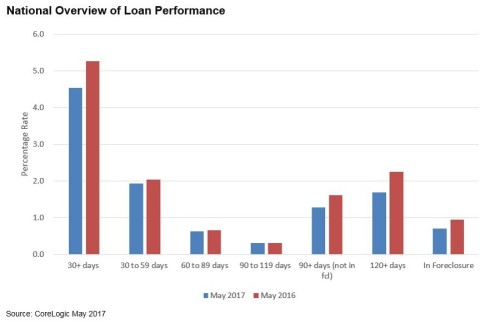- Economic Tailwinds Contributing to Healthy Mortgage Performance
- Early-Stage Delinquencies Among Lowest in 17 Years
- Early-Stage Transition Rates Improving
IRVINE, Calif. — (BUSINESS WIRE) — August 8, 2017 — CoreLogic® (NYSE: CLGX), a leading global property information, analytics and data-enabled solutions provider, today released its monthly Loan Performance Insights Report which shows that, nationally, 4.5 percent of mortgages were in some stage of delinquency (30 days or more past due including those in foreclosure) in May 2017. This represents a 0.8 percentage point decline in the overall delinquency rate compared with May 2016 when it was 5.3 percent.
This Smart News Release features multimedia. View the full release here: http://www.businesswire.com/news/home/20170808005522/en/

CoreLogic National Overview of Loan Performance for May 2017 (Graphic: Business Wire)
As of May 2017, the foreclosure inventory rate, which measures the share of mortgages in some stage of the foreclosure process, was 0.7 percent compared with 1 percent in May 2016. The serious delinquency rate, defined as 90 days or more past due including loans in foreclosure, was 2 percent, unchanged from April 2017 and down from 2.6 percent in May 2016. The 2 percent serious delinquency rate in April and May this year was the lowest since November 2007 when it was also 2 percent.
Measuring early-stage delinquency rates is important for analyzing the health of the mortgage market. To comprehensively monitor mortgage performance, CoreLogic examines all stages of delinquency as well as transition rates, which indicate the percentage of mortgages moving from one stage of delinquency to the next.
The rate for early-stage delinquencies, defined as 30-59 days past due, was 1.9 percent in May 2017, down from 2 percent in May 2016. The share of mortgages that were 60-89 days past due in May 2017 was 0.63 percent, down slightly from 0.66 percent in May 2016.
“Strong employment growth and home price increases have contributed to improved mortgage performance,” said Dr. Frank Nothaft, chief economist for CoreLogic. “Early-stage delinquencies are hovering around 17-year lows, and the current-to-30-day past due transition rate remained low at 0.8 percent. However, the same positive economic conditions helping performance have also contributed to a lack of affordable supply, creating challenges for homebuyers.”
Since early-stage delinquencies can be volatile, CoreLogic also analyzes transition rates. The share of mortgages that transitioned from current to 30-days past due was 0.8 percent in May 2017 compared with 0.9 percent in May 2016, a 0.1 percentage point decrease year over year. By comparison, in January 2007, just before the start of the financial crisis, the current-to-30-day transition rate was 1.2 percent and it peaked in November 2008 at 2 percent.
“A prolonged period of relatively tight underwriting criteria has driven delinquencies down to pre-crisis levels across many parts of the country,” said Frank Martell, president and CEO of CoreLogic. “As pressure to relax underwriting standards increases, the industry needs to proceed carefully and take progressive, sensible actions that protect hard-fought improvements in mortgage performance.”
For ongoing housing trends and data, visit the CoreLogic Insights Blog: www.corelogic.com/blog.
Methodology
The data in this report represents foreclosure and delinquency activity reported through May 2017.
The data in this report accounts for only first liens against a property and does not include secondary liens. The delinquency, transition and foreclosure rates are measured only against homes that have an outstanding mortgage. Homes without mortgage liens are not typically subject to foreclosure and are, therefore, excluded from the analysis. Approximately one-third of homes nationally are owned outright and do not have a mortgage. CoreLogic has approximately 85 percent coverage of U.S. foreclosure data.
Source: CoreLogic
The data provided is for use only by the primary recipient or the
primary recipient's publication or broadcast. This data may not be
re-sold, republished or licensed to any other source, including
publications and sources owned by the primary recipient's parent company
without prior written permission from CoreLogic. Any CoreLogic data used
for publication or broadcast, in whole or in part, must be sourced as
coming from CoreLogic, a data and analytics company. For use with
broadcast or web content, the citation must directly accompany first
reference of the data. If the data is illustrated with maps, charts,
graphs or other visual elements, the CoreLogic logo must be included on
screen or website. For questions, analysis or interpretation of the
data, contact Lori Guyton at
lguyton@cvic.com
or Bill Campbell at
bill@campbelllewis.com.
Data provided may not be modified without the prior written permission
of CoreLogic. Do not use the data in any unlawful manner. This data is
compiled from public records, contributory databases and proprietary
analytics, and its accuracy is dependent upon these sources.








